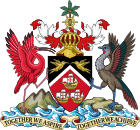1925 Trinidad and Tobago general election
 |
|---|
|
|
General elections were held in Trinidad and Tobago for the first time on 7 February 1925.[1]
Background
[edit]The Legislative Council had been established in 1831, but was a fully nominated body.[1] In July 1921, San Fernando Borough Council called a public meeting at Carnegie Library, the result of which was a unanimous request for elected representation. Similar demands subsequently came from Arima and Port of Spain.[1] Within a few years, the British authorities agreed to a partly elected legislative council, although with voting limited to a restricted franchise.[1]
Electoral system
[edit]The reorganised Legislative Council had 12 official members (civil servants), six nominated members, seven elected members and the Governor, who served as the legislature's speaker. The seven elected members were elected from single-member constituencies.[2]
The franchise was limited to people who owned property in their constituency with a rateable value of $60 (or owned property elsewhere with a rateable value of $48) and tenants or lodgers who paid the same sums in rent. The voting age was 21 for men and 30 for women, and all voters were required to understand spoken English.[1] Anyone who had received poor relief within the most recent six months before election day was disqualified from voting.[2] Only 6% of the population were eligible to vote.[2]
The restrictions on candidates were more severe, with candidature limited to men that lived in their constituency, were literate in English, and owned property worth at least $12,000 or from which they received at least $960 in rent a year. For candidates who had not lived in their constituency for at least a year, the property values were doubled.[1]
Results
[edit]Voter turnout was around 29%, with two constituencies having only one candidate.[2] Three of the seven elected members – Arthur Andrew Cipriani, Charles Henry Pierre and Albert Victory Stollmeyer – were supported by the Trinidad Workingmens' Association,[3] as was the losing candidate in Tobago, Isaac Hope.[4]
| Constituency | Candidate | Votes | Notes |
|---|---|---|---|
| Caroni County | Sarran Teelucksingh | 491 | Elected |
| E.A. Robinson | 235 | ||
| Eastern Counties | Charles Henry Pierre | – | Elected unopposed |
| Port of Spain | Arthur Andrew Cipriani | 2,557 | Elected |
| Randolph Rust | 910 | ||
| Gaston Johnson | 378 | ||
| Saint George County | Albert Victor Stollmeyer | 707 | Elected |
| A. Cory Davies | 206 | ||
| Saint Patrick County | Ernest Radcliffe Clarke | 314 | Elected |
| A.A. Sobrian | 269 | ||
| Tobago | James Alexander Biggart | Elected | |
| Isaac Hope | |||
| Victoria County | Thomas Meade Kelshall | – | Elected unopposed |
| Source: Teelucksingh | |||
Appointed members
[edit]| Position | Member |
|---|---|
| Governor | Horace Byatt |
| Collector of Customs | Thomas Robert Cutler |
| Colonial Secretary | Thomas Alexander Vans Best |
| Acting Colonial Secretary | Robert Howard Furness |
| Director of Agriculture | William George Freeman |
| Director of Education | George Mackay |
| Director of Public Works | Matthew Alexander Murphy |
| General Manager of Railways | John Powter |
| Inspector General of Constabulary | George Hebert May |
| Protector of Immigrants | Arnauld Henry William De Boissiere |
| Acting Solicitor-General | Walter Harragin |
| Surgeon-General | Kenrick Stanton Wise |
| Treasurer | Henry Barclay Walcott |
| Nominated members | Henry Alcazar |
| Albert Bonus Carr | |
| Alexander Frazer | |
| George Frederick Huggins | |
| Arthur Hutton McShine | |
| Lennox O'Reilly | |
| Source: Teelucksingh, Skinner[5] | |
